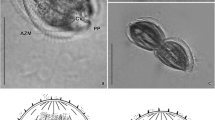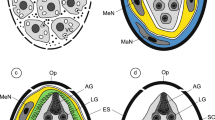Summary
The most prominent ultrastructural characteristics of the cyst ofHaptoglossa mirabilis are a large centrally-placed nucleus which is partially ringed by three or four parallel cisternae of rough endoplasmic reticulum (r-ER), a centriole pair and single large Golgi complex which occupy the anterior end of the cell, and a population of provacuoles which occupies the posterior. During germination these organelles migrate into a narrow germ tube which subsequently expands to form the gun cell initial. The extracellular components of the attack apparatus (i.e. missile and injection tube) are formed entirely in the developing gun cell; indirect evidence suggests that both the Golgi complex and r-ER are involved in their synthesis. The intra-cellular component of the attack apparatus comprises the posterior, anterior and apical vacuoles. The posterior vacuole forms by fusion and expansion of the original cyst provacuoles; the formation of the anterior and apical vacuoles occurs late in gun cell differentiation and involves fusion of Golgi-derived vesicles.
Similar content being viewed by others
References
Barron GL (1977) The nematode destroying fungi. Top Microbiol 1: 140. Canadian Biological Publications, Guelph, Ontario.
— (1980) A newHaptoglossa attacking rotifers by rapid injection of an infective sporidium. Mycologia 72: 1186–1194
Canning EU (1977) Microsporidia in parasitic protozoa. Kreier J (ed) Academic Press, New York, pp 155–196
Jensen HM, Wellings SR (1972) Development of the polar filament-polaroplast complex in a microsporidian parasite. J Protozool 19: 297–306
Lom J, Corliss JO (1967) Ultrastructural observations on the development of the microsporidian protozoonPlistophora hyphessobryconis Schapeclaus. J Protozool 14: 141–152
Manton I (1967) Further observations on the fine structure ofChrysochromulina chiton with special reference to the Haptonema, peculiar Golgi structure and scale production. J Cell Sci 2: 265–272
Robb EJ, Barron GL (1982) Nature's ballistic missile. Science 218: 1221–1222
Robb J,Lee B (1986) Ultrastructure of mature and fired gun cells ofHaptoglossa mirabilis. Can J Bot (in press).
Vavra J (1978) In:Vavra J, Sprague V (ed) The microsporidia. Plenum Press, New York
Author information
Authors and Affiliations
Rights and permissions
About this article
Cite this article
Robb, J., Lee, B. Developmental sequence of the attack apparatus ofHaptoglossa mirabilis . Protoplasma 135, 102–111 (1986). https://doi.org/10.1007/BF01277003
Received:
Accepted:
Issue Date:
DOI: https://doi.org/10.1007/BF01277003




